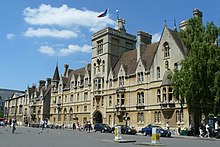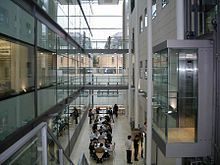
History at Oxford
Oxford is celebrated for the broad chronological sweep of its courses and the enormous amount of choice offered to students. You can study options on any part of British and European history from the declining years of the Roman Empire to the present day. The geographical range is also broad: there are options on North American, Latin American, Asian and African history (see website for further details). Students are encouraged to adopt a variety of interdisciplinary approaches to their work, and the faculty is strong on intellectual and cultural history options. The Oxford History Faculty is at the forefront of research.
Buildings, collections, and facilities
Main sites
The University is a "city university" in that it does not have a main campus; instead, colleges, departments, accommodation, and other facilities are scattered throughout the city centre. The Science Area, in which most science departments are located, is the area that bears closest resemblance to a campus. The ten-acre Radcliffe Observatory Quarter in the northwest of the city is currently under development. However, the larger colleges' sites are of similar size to these areas.
Iconic university buildings include the Sheldonian Theatre used for music concerts, lectures, and university ceremonies, and Examination Schools, where examinations and some lectures take place. The University Church of St Mary the Virgin was used for university ceremonies before the construction of the Sheldonian. Christ Church Cathedral uniquely serves as both a college chapel and as a cathedral.
In 2012, the University embarked on the controversial one-hectare (400m × 25m) Castle Mill development of 4–5 storey blocks of student flats overlooking Cripley Meadow and the historic Port Meadow, blocking views of the spires in the city centre. The development has been likened to building a "skyscraper beside Stonehenge".
Libraries
The University maintains the largest university library system in the UK;and, with over 11 million volumes housed on 120 miles (190 km) of shelving, the Bodleian group is the second-largest library in the UK, after the British Library. The Bodleian is a legal deposit library, which means that it is entitled to request a free copy of every book published in the UK. As such, its collection is growing at a rate of over three miles (five kilometres) of shelving every year.
The buildings referred to as the University's main research library, The Bodleian, consist of the original Bodleian Library in the Old Schools Quadrangle, founded by Sir Thomas Bodley in 1598 and opened in 1602, the Radcliffe Camera, the Clarendon Building, and the New Bodleian Building. A tunnel underneath Broad Street connects these buildings, with the Gladstone Link connecting the Old Bodleian and Radcliffe Camera opening to readers in 2011.
The Bodleian Libraries group was formed in 2000, bringing the Bodleian Library and some of the subject libraries together. It now comprises 28 libraries, a number of which have been created by bringing previously separate collections together, including the Sackler Library, Social Science Library and Radcliffe Science Library. Another major product of this collaboration has been a joint integrated library system, OLIS (Oxford Libraries InformationSystem), and its public interface, SOLO (Search Oxford Libraries Online), which provides an electronic catalogue covering all member libraries, as well as the libraries of individual colleges and other faculty libraries, which are not members of the group but do share cataloguing information.
A new book depository opened in South Marston, Swindon in October 2010,and current building projects include the remodelling of the New Bodleian building, which will be renamed the Weston Library when it reopens in 2014-15. The renovation is designed to better showcase the library’s various treasures (which include a ShakespeareFirst Folio and a Gutenberg Bible) as well as temporary exhibitions.
Museums
Oxford maintains a number of museums and galleries, open for free to the public. The Ashmolean Museum, founded in 1683, is the oldest museum in the UK, and the oldest university museum in the world. It holds significant collections of art and archaeology, including works by Michelangelo, Leonardo da Vinci,Turner, and Picasso, as well as treasures such as the Scorpion Macehead, the Parian Marble and the Alfred Jewel. It also contains "The Messiah", a pristine Stradivarius violin, regarded by some as one of the finest examples in existence.
The University Museum of Natural History holds the University’s zoological, entomological and geological specimens. It is housed in a large neo-Gothic building on Parks Road, in the University’s Science Area. Among its collection are the skeletons of a Tyrannosaurus rex and Triceratops, and the most complete remains of a dodo found anywhere in the world. It also hosts the Simonyi Professorship of the Public Understanding of Science, currently held by Marcus du Sautoy.
Adjoining the Museum of Natural History is the Pitt Rivers Museum, founded in 1884, which displays the University’s archaeological and anthropological collections, currently holding over 500,000 items. It recently built a new research annexe; its staff have been involved with the teaching of anthropology at Oxford since its foundation, when as part of his donation General Augustus Pitt Rivers stipulated that the University establish a lectureship in anthropology.
The Museum of the History of Science is housed on Broad St in the world’s oldest-surviving purpose-built museum building.It contains 15,000 artefacts, from antiquity to the 20th century, representing almost all aspects of the history of science. In the Faculty of Music on St Aldate's is the Bate Collection of Musical Instruments, a collection mostly of instruments from Western classical music, from the medieval period onwards. Christ Church Picture Gallery holds a collection of over 200 old master paintings.
Parks
The University Parks are a 70-acre parkland area in the northeast of city. It is open free of charge to the public during daylight hours. As well as providing beautiful gardens and rare and exotic plants, the parks contains numerous sports fields, used for official and unofficial fixtures. In addition to this, the University Parks contain sites of special interest including the Genetic Garden, an experimental garden to elucidate and investigate evolutionary processes.
The Botanic Garden on the High Street is the oldest botanic garden in the UK and the third-oldest scientific garden in the world. It contains over 8,000 different plant species on 1.8 hectares (4½ acres). It is one of the most diverse yet compact collections of plants in the world and includes representatives from over 90% of the higher plant families. The Harcourt Arboretum is a 130-acre site six miles south of the city that includes native woodland and 67 acres of meadow. The 1,000-acre Wytham Woods are owned by the University and used or research in zoology and climate change.
There are also various collegiate-owned open spaces open to the public, including Bagley Wood and most notably Christ Church Meadow
REPUTATION RANK
2013Oxford, United Kingdom
Region: Europe
- Overall reputation score73
- Reputation (teaching)75.8
- Reputation (research)71.7
Address: University Offices, Wellington Square, Oxford OX1 2JD, United Kingdom
Color: Oxford Blue
Acceptance rate: 20.5% (2012)
Enrollment: 22,177 (December 1, 2012)
Phone: +44 1865 270000
Motto: Dominus Illuminatio Mea, The Lord is my Light
Architect: James Stirling







No comments:
Post a Comment